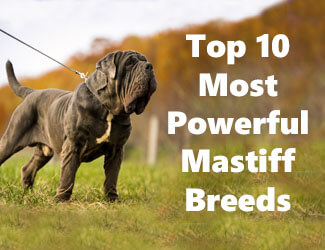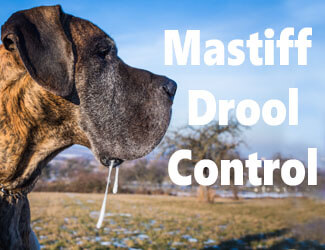Mastiff Dog Facts and
Info
15 Interesting Things About This Breed
by Ken Alden
Mastiff dog facts and info can be as colorful and varied as the breed itself.
This breed gained popularity as a family pet or guard dog because they're
formidable and instinctive defenders while on the other hand they love to snuggle. You may have read about these particular traits,
but, really, how familiar are you with this ancient dog breed? Wouldn't it be
great if you could learn some interesting facts about them before you decide on
raising one?
Some Fascinating Mastiff Dog Facts And Info...
- It's a direct descendant of Roman war dogs.
- This breed almost went extinct three times!
- They may be ancient war dogs, but they hate conflicts.
- This dog held the title of the heaviest breed in the world!
- Its puppy stage lasts for 24 months!
Did those catch your attention? Well, you're in for a treat, because that's just the tip of the iceberg. Stick around to learn more about Mastiffs, as we'll discuss their history, temperament, and characteristics in great detail! Read More Below...
Pro-tip: Ever try lifting a Mastiff? Their weight can hurt not only your back but their joints when they hop down from cars, sofas or even your bed. To protect your back and theirs check out the best Mastiff ramps on Amazon.com now.

Mastiff History Facts And Info
Here are five interesting facts about the history of this breed:
- They're a direct descendent of Molossus—an Ancient Roman war dog.
Several ancient writings, including Aristophanes' Thesmophoriazusae,
Aristotle's History of Animals, have all mentioned this legendary
breed. You can find statues of Molossus in the British Museum, and they're
eerily identical to today's English Mastiff! mastiff dog facts and info
- Most historians believe that Phoenician
traders brought the Mastiffs to ancient Britain. Ancient
Britons used them to guard properties and castles long before anyone learned
about this majestic breed. That's why most experts believe that the English
Mastiffs we have today is the contribution of ancient Britain.
- Carthaginian general, Hannibal,
was mostly responsible for the wide distribution of the various crossbreeds of
Mastiffs that we have today. In 218 BC, Hannibal brought battalions of
war-trained Mastiffs to accompany him with his journey across the Alps. Historians believe that these
dogs met with the giant mountain dogs of the Balkans, France, Spain, and
Turkey, which led to various breeds of mastiffs, including the notorious Alpine
Mastiff—the ancestor of St.
Bernard. mastiff dog facts and info
- Despite its long history throughout the world, the United States never had a real importation of Mastiffs until the late 1800s. There were traces of records of Mastiffs accompanying the Plymouth Colony on the Mayflower. But historians are convinced that we can only trace its origins in the US as far as the late 1800s. mastiff dog facts and info
- The Mastiffs that we have today came close to the brink of extinction thrice! The Parliament of the United Kingdom enacted the Cruelty to Animals Act 1835, which outlawed various brutal sports such as bull-baiting, bear-baiting, and dogfighting. The popularity of dog shows in the mid-19th century revived the interest in Mastiffs, then World War I and II happened, which almost eradicated this breed due to food shortage.
Mastiff Temperament Facts And Info
Their temperament is the reason why they're one of the most popular guard dogs today. Despite being a progeny of war dogs and after surviving World War I and II, they still have a well-balanced behavior that makes them perfect as a family pet.
Here are five interesting facts about the temperament of this breed:
- They're fearless outside, but soft and affectionate inside. They may be a direct descendant of Roman war dogs, but Mastiffs
don't like any form of conflict. This breed often acts as an intermediary,
getting in between family members, whenever there's a conflict between them.
They're also very sensitive to emotions and may grow to fear humans if treated with harshness.
Pro-tip: Mastiff anxiety, aggression, destructive chewing, jumping up, fearfulness, and other behaviors can be controlled with the right training program.
Here’s a great course that
addresses these issues along with many other dog training basics: Check it out now!
- This breed is loyal and devoted to its owner and other family members. A Mastiff is always watchful of strangers and is, sometimes, overly aggressive to protect its owner. This temperament can result in various reactions, including defensive bites, which makes training a crucial process to have them under control.
- They'll protect their territory, but they won't bark to intimidate. Put them in your property, and they'll treat it as their own. They'll bite before they bark, and they won't hesitate to take down a stranger who steps in their territory—humans and animals alike. mastiff dog facts and info
- They'll mature into gentle giants through adequate socialization with other people and animals. There's no doubt that they're fearless and always suspicious of strangers, but when they receive enough socialization, they develop a strong differentiation between the good and bad guys. It won't eliminate their suspicion of other people, but they'll be a well-mannered dog that's ready to step in whenever there's a threat.
- Despite their strong instincts, their behavior development remains unpredictable and can change due to various factors. It can be challenging to raise a puppy because socialization, training, and other activities can have various effects on their behavior as they grow up. Two Mastiff puppies, for example, that received the same amount of socialization and training, may result in one being polite, while the other can be overly fearful of people.
Mastiff Characteristic Facts And Info
The strong, distinct characteristics of this breed are the building blocks of their role as guard dogs. Aside from their size, did you know that there are several little-known facts about the characteristics of this dog?
Here are five interesting facts about the characteristics of this breed:
- Mastiffs have the biggest litter with an average of 10 to 12 puppies. Although there are some flukes of nature, like Tia, a Neapolitan Mastiff that gave birth to 24 puppies, English Mastiffs still have the biggest litter by average. It can be challenging for breeders, but experts believe that it's one of the characteristics that made this breed stand the test of time and survived through multiple extinction events.
Pro-tip: Mastiff's (and their owners) love dog crates…and for good reasons. Crates keep dogs from mischief while you're away, are perfect for house training, for traveling by car, and provide the dog a place to de-stress. Check out the best Mastiff crates on Amazon.com now.
- They're massive, but did you know that they grow so big, the AKC (American Kennel Club) doesn't have a maximum height and weight for this breed's standard? The standard minimum height is 30 inches (76 cm) for males and 27.5 inches (70 cm) for females. There's no specific standard for this dog's weight, but an average adult male can weigh anywhere from 72 to 104 kgs (160 to 230 lbs), while females have an average weight of 54 to 77 kgs (120 to 170 lbs). mastiff dog facts and info
- The first dog to hold the Guinness Book of World Records as the heaviest and longest dog in the world is an English Mastiff! Zorba, the Mastiff, set the record in 1987 weighing 143 kgs (315 lbs), and again in 1989 weighing 149.7 kgs (330 lbs). He measured 37 inches (94 cm) high at the shoulder and 99 inches (251.46 cm) long from the tip of his nose to the tip of his tail!
- The puppy stage for this dog lasts longer than most dog breeds! They may be large, but on average, it'll take 18 to 24 months before a Mastiff reaches full maturity! They'll be extremely playful from early stages until a year or two, but owners should avoid stressful activities that can cause injuries.
- They do well with a sedentary lifestyle. But it doesn't mean that they don't need exercise. You'll have to do moderate, daily exercises to keep them in tip-top shape. They can adapt well with indoor living, and despite their need for large spaces, they'll be mostly quiet and calm when staying indoors.
Mastiff Dog Facts And Info...Final Thoughts
Mastiffs may seem like a breed that only has brute
force, but they're more sophisticated than most dogs. They've been useful for
people throughout history, showing high efficiency, proactiveness, compassion,
and loyalty towards their owners. mastiff dog facts and info
If you're planning on raising one, these facts
about their temperament and characteristics will help you understand how to
manage them well. They may be highly territorial dogs that won't hesitate to
take down anyone, but if you're able to build deep ties with them, they'll show
great devotion and care over you and your family.
Return to the top of this Mastiff Dog Facts And Info page

About the Author...
Ken Alden, a dedicated Mastiff owner for over eight years, is acclaimed for his expertise in care, grooming, and training. Read more About Me and my dog Shadow.
- Mastiff Guide Home ›
- Mastiff Dog ›
- Mastiff Dog Facts And Info






